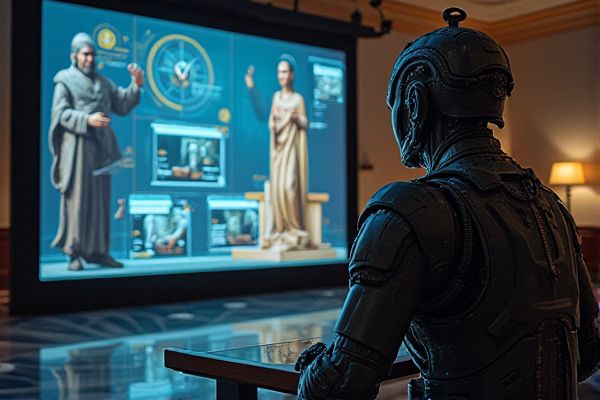
AI technologies play a crucial role in preserving and analyzing cultural heritage. Through image recognition and machine learning, AI can identify and restore damaged artifacts, ensuring their longevity for future generations. Natural language processing facilitates the translation and interpretation of ancient texts, making them accessible to a wider audience. Virtual reality applications allow people to explore historical sites and experiences that might otherwise be lost or unreachable.
AI usage in cultural heritage
Digitization and Preservation
AI has the potential to enhance the digitization and preservation of cultural heritage by improving the efficiency of data processing. For example, institutions like The British Museum can utilize AI algorithms to catalog and restore artifacts more accurately. This technology can analyze patterns and create virtual reconstructions, allowing for better access to cultural items. The chance of creating immersive experiences through AI-driven applications may also increase public engagement with cultural heritage.
Restoration and Reconstruction
AI can significantly enhance cultural heritage through innovative restoration and reconstruction techniques. By analyzing historical data, AI models can predict the most effective methods for preserving artifacts, such as ancient manuscripts or sculptures. Institutions like the Getty Conservation Institute are exploring AI's potential in creating 3D reconstructions of lost heritage sites. This technology offers a chance to engage broader audiences and deepen appreciation for cultural history.
Virtual Reality Experiences
AI can enhance cultural heritage preservation by generating accurate reconstructions of historical sites. For instance, institutions like the British Museum utilize AI tools to create immersive virtual reality experiences. This technology allows users to explore artifacts and sites in a way that was previously impossible. Such advancements could increase public interest and engagement with history, providing educational advantages.
Cultural Data Analysis
AI can enhance cultural heritage preservation by analyzing vast datasets, identifying patterns that may not be visible to human researchers. For instance, cultural data analysis can help in the restoration of artworks by predicting color palettes used by specific artists. This technological application can improve the documentation of historical events through the aggregation of diverse cultural narratives. Leveraging AI tools may provide insights that lead to better strategies for heritage management and engagement.
Language Translation and Restoration
AI can assist in the preservation of cultural heritage by analyzing historical artifacts and offering insights that human researchers might overlook. In language translation, AI technologies, such as neural machine translation, enhance communication across different languages, which can facilitate cultural exchanges. Restoration of artwork and historical documents can benefit from AI algorithms that predict the original state of deteriorated pieces, thereby improving accuracy. These advancements present the possibility of enriching cultural understanding and appreciation on a global scale.
Provenance and Ownership Tracking
AI can enhance cultural heritage preservation by automating provenance and ownership tracking of artifacts. For example, institutions like the British Museum can utilize AI algorithms to manage and verify the history of their collections. By analyzing metadata and image recognition, AI can identify discrepancies and confirm legitimacy in ownership claims. This technology may lead to greater transparency and efficient retrieval of historical data, benefiting researchers and institutions alike.
Visitor Engagement and Personalization
AI can enhance visitor engagement in cultural heritage sites by creating personalized experiences tailored to individual preferences. For instance, museums like the Louvre can use AI algorithms to suggest specific exhibits based on a visitor's interests and past interactions. This not only enriches the visitor experience but also potentially increases the time spent at the institution. Employing such technology may lead to higher visitor satisfaction and improved attendance rates.
Pattern Recognition in Artifacts
AI's application in cultural heritage can significantly enhance the analysis of artifacts through pattern recognition techniques. This technology allows researchers to identify similarities and differences in historical items, such as ancient pottery styles from various archaeological sites. Developing software tools that employ machine learning algorithms could lead to more efficient cataloging and preservation efforts conducted by institutions like the Smithsonian. Such advancements may not only improve research accuracy but also increase public engagement with cultural heritage through interactive displays and educational resources.
Educational Accessibility
AI has the potential to enhance cultural heritage preservation by enabling virtual reconstructions of historical sites. For instance, institutions like the Getty Museum use AI to analyze and restore artworks, making them more accessible to the public. In educational contexts, AI-driven tools can provide personalized learning experiences, offering tailored resources for diverse learners. This approach can significantly improve educational accessibility for students with disabilities, increasing their chances of academic success.
Collaborative Research Platforms
AI has the potential to enhance cultural heritage preservation by analyzing large datasets related to historical artifacts. Collaborative research platforms, such as Europeana, facilitate the sharing of knowledge and resources among institutions to improve access to cultural materials. The integration of AI can streamline these collaborative efforts, making it easier to identify patterns or uncover insights from digitized collections. This synergy may lead to innovative approaches in heritage conservation and education.
 techknowy.com
techknowy.com